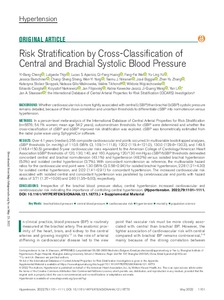Risk Stratification by Cross-Classification of Central and Brachial Systolic Blood Pressure
Cheng Yi-Bang; Thijs Lutgarde; Aparicio Lucas S.; Huang Qi-Fang; Wei Fang-Fei; Yu Yu-Ling; Barochiner Jessica; Sheng Chang-Sheng; Yang Wen-Yi; Niiranen Teemu J.; Boggia José; Zhang Zhen-Yu; Stolarz-Skrzypek Katarzyna; Gilis-Malinowska Natasza; Tikhonoff Valérie; Wojciechowska Wiktoria; Casiglia Edoardo; Narkiewicz Krzysztof; Filipovský Jan; Kawecka-Jaszcz Kalina; Wang Ji-Guang; Li Yan; Staessen Jan A.
https://urn.fi/URN:NBN:fi-fe2022081154284
Tiivistelmä
Background: Whether cardiovascular risk is more tightly associated with central (cSBP) than brachial (bSBP) systolic pressure remains debated, because of their close correlation and uncertain thresholds to differentiate cSBP into normotension versus hypertension.
Methods: In a person-level meta-analysis of the International Database of Central Arterial Properties for Risk Stratification (n=5576; 54.1% women; mean age 54.2 years), outcome-driven thresholds for cSBP were determined and whether the cross-classification of cSBP and bSBP improved risk stratification was explored. cSBP was tonometrically estimated from the radial pulse wave using SphygmoCor software.
Results: Over 4.1 years (median), 255 composite cardiovascular end points occurred. In multivariable bootstrapped analyses, cSBP thresholds (in mm Hg) of 110.5 (95% CI, 109.1-111.8), 120.2 (119.4-121.0), 130.0 (129.6-130.3), and 149.5 (148.4-150.5) generated 5-year cardiovascular risks equivalent to the American College of Cardiology/American Heart Association bSBP thresholds of 120, 130, 140, and 160. Applying 120/130 mm Hg as cSBP/bSBP thresholds delineated concordant central and brachial normotension (43.1%) and hypertension (48.2%) versus isolated brachial hypertension (5.0%) and isolated central hypertension (3.7%). With concordant normotension as reference, the multivariable hazard ratios for the cardiovascular end point were 1.30 (95% CI, 0.58-2.94) for isolated brachial hypertension, 2.28 (1.21-4.30) for isolated central hypertension, and 2.02 (1.41-2.91) for concordant hypertension. The increased cardiovascular risk associated with isolated central and concordant hypertension was paralleled by cerebrovascular end points with hazard ratios of 3.71 (1.37-10.06) and 2.60 (1.35-5.00), respectively.
Conclusions: Irrespective of the brachial blood pressure status, central hypertension increased cardiovascular and cerebrovascular risk indicating the importance of controlling central hypertension.
Kokoelmat
- Rinnakkaistallenteet [27094]
